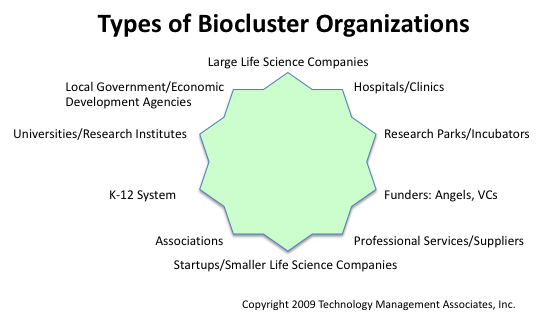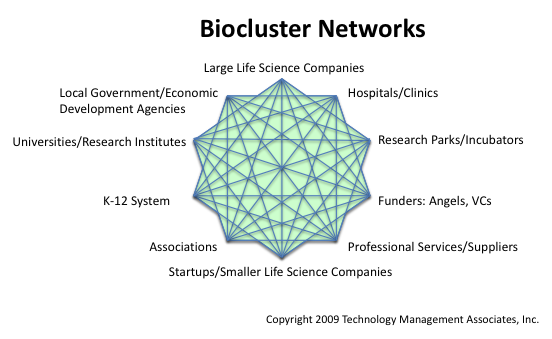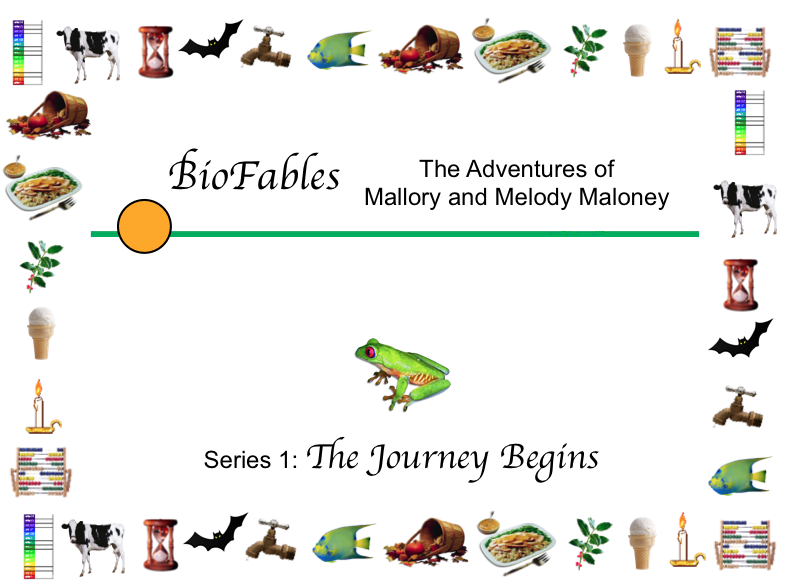INTRODUCTION TO BIOCLUSTERS
(NOTE: We're just beginning to populate the U.S. Biocluster resource links).
What makes a specific geographic area a biocluster? What defines a successful biocluster? What are the factors that improve the odds of success?
Let's look at each of these questions in turn. First, what is a biocluster?
A single big company or research laboratory, no matter how excellent, does not by itself constitute a biocluster. Most observers agree that a biocluster has a number of different kinds of organizations that make up a "critical mass" within a geographic region that is easily accessible by its members (varies by location, but we tend to think of distance in terms of travel time of no more than 45-60 minutes) . We'll discuss critical mass in a moment.
What kinds of organizations are these?
The diagram below shows the 10 types of organizations we've identified that appear to be crucial in the development of a strong biocluster. While some segments may be more influential than others, each contributes to the overall success of a biocluster.

What are the specific measures of success? While emerging bioclusters have different needs from established areas, most lists would include the number of new products commercialized or undergoing clinical trials, patents and patent applications, IPOs (Initial Public Offerings), technical or scientific publications, partnerships established, investment activity and global reach.
What are the attributes or factors that improve the odds of success, in addition to the education, legislation and funding that are inherent in universities, government, angels and other identified organizations.
First of all, critical mass. The 10 types of organizations are now linked with each other in the diagram below. You can see that a single venture capitalist or accounting firm or university would have limited ability to form links with all the other centers of influence. On the other hand, you can visualize how multiple organizations vastly increase the number of links.

Next, diversity. The diversity in types of organizations brings obvious advantages.
Startups and smaller companies can receive funding, grants and other support from large companies, angels and venture capitalists, associations and nearly all of the other 10 types of organizations. Research parks and incubators may receive tax or other considerations for local government and economic development agencies. The potential for creative relationships among different types of organizations is limited only by the imagination of the players.
The diversity that multiple organizations of the same type bring to the biocluster offer interactive opportunities as well as improvements that tend to occur naturally from the presence of competition. For example, multiple universities with different specialties and areas of expertise can group together to form consortia, accomplishing more with their synergy than they could accomplish on their own.
Furthermore, when any organization extends its reach beyond the local community, it is able to bring new value to all the members in its network by enabling the establishment and growth of new regional, national and even global networks.
Finally, people. People with excellent technical skills, though absolutely essential, need to be supplemented with people who have marketing savvy, other people who can initiate and manage the tech transfer process, still others who are visionaries who see synergies and potential that others may miss.
Despite all the research, communication and infrastructure technologies available to us, geography -- geographic proximity -- still matters. Why? In a word, Vibrancy. Vibrancy, generated by people living, working and interacting with each other, creates the sparks that energize it as a successful biocluster community.
Is there a "secret ingredient" that causes one biocluster to flourish while another languishes, despite similar organizations, critical mass, diversity and numbers of people? We posit that there is. The secret ingredient is revealed in the children's story of the little red hen. If you're not familiar with the story, search on the phrase "little red hen."
Do you want a sneak preview of our soon-to-be-introduced "little red hen" services? Contact us for more information: jogucwa@techmanage.com.
Login
Advertisements
Colorless, odorless, biodegradable instant sanitizer is effective against both gram positive and gram-negative bacteria; kills in 30 seconds. Free of chlorine and quaternary ammonium compounds. EPA registered food contact surface sanitizer. Austin Davis Industries, Inc.
Safe, totally natural, 100% biodegradable, multi-functional cleaning product providing safety in the workplace for both humans and environmental surfaces - without compromising performance. Can be diluted up to 25:1. Austin Davis Industries, Inc.





